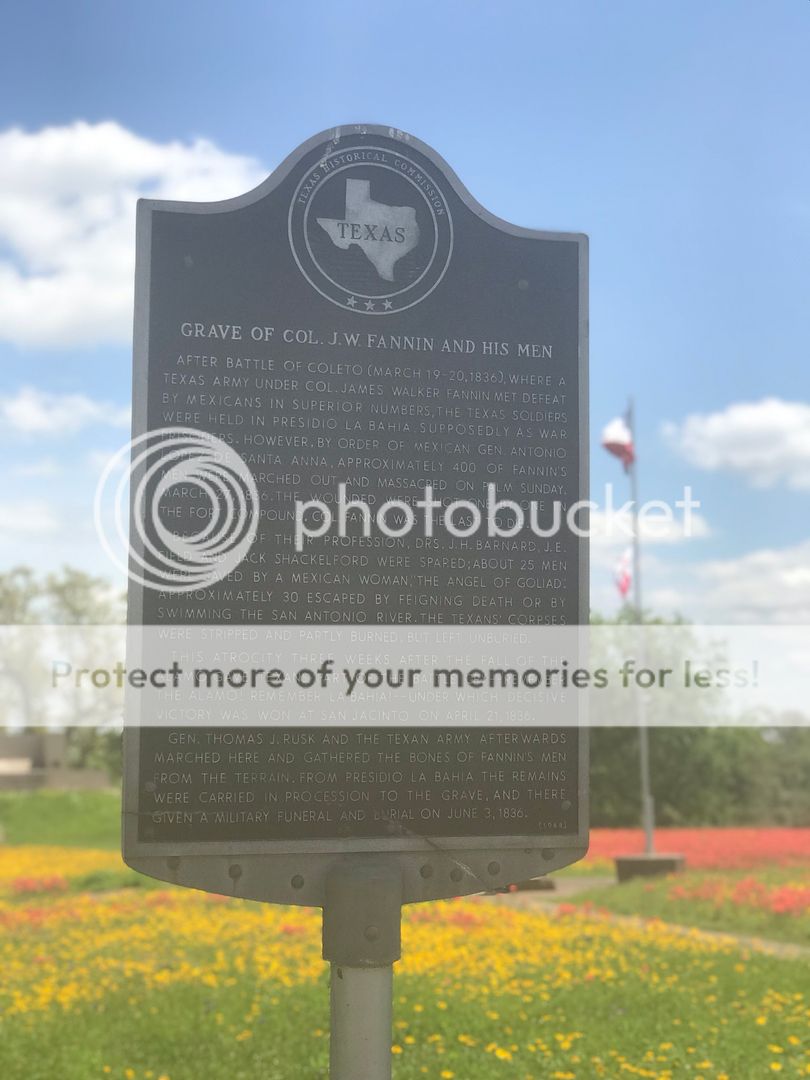After the battle of Coleto those Texans that could walk were sent to Goliad, under Mexican escort. It would take until about March 23 until those Texans that could not walk were transported to Goliad. During that time, Mexican physicians were told that wounded Mexicans were a priority to treat, as opposed to the wounded Texans. Fannin arrived in Goliad on March 22. Urrea, meanwhile, had moved on to Guadalupe Victoria, from where he wrote to Santa Anna a letter recommending that the Texan prisoners should be treated with clemency.
On March 23, Santa Anna replied to Urrea's letter regarding Fannin and the other captured Texans. In this communication, he directly ordered Urrea to execute the prisoners which he dubbed "perfidious foreigners." This order was repeated in a letter on March 24. Concerned about Urrea's willingness to comply, Santa Anna also dispatched a note to Colonel José Nicolás de la Portilla, the commander at Goliad, ordering him to shoot the prisoners. Received on March 26, it was followed two hours later by a conflicting letter from Urrea telling him to "treat the prisoners with consideration" and to use them to rebuild the town. Though a noble gesture by Urrea, the general was aware that Portilla lacked sufficient men to guard the Texans during such an endeavor. Weighing both orders during the night, Portilla concluded that he was required to act on Santa Anna's directive. Santa Anna sent a direct order to the "Officer Commanding the Post of Goliad" to execute the prisoners in his hands. This order was received on March 26 by Col. José Nicolás de la Portilla, whom Urrea had left at Goliad. Two hours later Portilla received another order, this one from Urrea, "to treat the prisoners with consideration, and especially their leader, Fannin," and to employ them in rebuilding the town. But when he wrote this seemingly humane order, Urrea well knew that Portilla would not be able to comply with it, for on March 25, after receiving Santa Anna's letter, Urrea had ordered reinforcements that would have resulted in too large a diminution of the garrison for the prisoners to be employed on public works. Portilla suffered an unquiet night weighing these conflicting orders, but he concluded that he was bound to obey Santa Anna's order and directed that the prisoners be shot at dawn.
At sunrise on Palm Sunday, March 27, 1836, the unwounded Texans were formed into three groups under heavy guard commanded by Capt. Pedro Balderas, Capt. Antonio Ramírez, and first adjutant Agustín Alcérrica (a colonel in the Tres Villas Battalion in April 1836). The largest group, including what remained of Ward's Georgia Battalion and Capt. Burr H. Duval's company, was marched toward the upper ford of the San Antonio River on the Bexar road. The San Antonio Greys, Mobile Greys, qqv and others were marched along the Victoria road in the direction of the lower ford. Capt. John Shackelfordqv's Red Rovers and Ira J. Westover's regulars were marched southwestwardly along the San Patricio road. The guard, which was to serve also as a firing squad, included the battalions of Tres Villas and Yucatán, dismounted cavalry, and pickets from the Cuautla, Tampico, and Durango regiments.
The prisoners held little suspicion of their fate, for they had been told a variety of stories - they were to gather wood, drive cattle, be marched to Matamoros, or proceed to the port of Copano for passage to New Orleans. Only the day before, Fannin himself, with his adjutant general, Joseph M. Chadwick, had returned from Copano, where, accompanied by Holsinger and other Mexican officers, they had tried to charter the vessel on which William P. Miller's Nashville Battalion had arrived earlier (these men had been captured and imprisoned at Goliad, also). Although this was really an attempt by Urrea to commandeer the ship, the vessel had already departed. Still, Fannin became cheerful and reported to his men that the Mexicans were making arrangements for their departure. The troops sang "Home Sweet Home" on the night of March 26.
At selected spots on each of the three roads, from half to three-fourths of a mile from the presidio, the three groups were halted. The guard on the right of the column of prisoners then countermarched and formed with the guard on the left. At a prearranged moment, or upon a given signal, the guards fired upon the prisoners at a range too close to miss. Nearly all were killed at the first fire. Those not killed were pursued and slaughtered by gunfire, bayonet, or lance. Fannin and some forty (Peña estimated eighty or ninety) wounded Texans unable to march were put to death within the presidio under the direction of Capt. Carolino Huerta of the Tres Villas battalion.
From two groups shot on the river roads, those not instantly killed fled to the woods along the stream, and twenty-four managed to escape. The third group, on the San Patricio road, was farther from cover; only four men from it are known to have escaped. A man-by-man study of Fannin's command indicates that 342 were executed at Goliad on March 27. Only twenty-eight escaped the firing squads, and twenty more were spared as physicians, orderlies, interpreters, or mechanics largely because of the entreaties of Francita Alvarez, a "high bred beauty" whom the Texans called the "Angel of Goliad", and the brave and kindly intervention of Col. Francisco Garay. Many of those who eventually escaped were first recaptured and later managed a second escape. Two physicians, Joseph H. Barnard and John Shackelford, were taken to San Antonio to treat Mexican wounded from the battle of the Alamo; they later escaped.
After the executions the bodies were burned, the remains left exposed to weather, vultures, and coyotes, until June 3, 1836, when Gen. Thomas J. Rusk gathered the remains and buried them with military honors.
On March 23, Santa Anna replied to Urrea's letter regarding Fannin and the other captured Texans. In this communication, he directly ordered Urrea to execute the prisoners which he dubbed "perfidious foreigners." This order was repeated in a letter on March 24. Concerned about Urrea's willingness to comply, Santa Anna also dispatched a note to Colonel José Nicolás de la Portilla, the commander at Goliad, ordering him to shoot the prisoners. Received on March 26, it was followed two hours later by a conflicting letter from Urrea telling him to "treat the prisoners with consideration" and to use them to rebuild the town. Though a noble gesture by Urrea, the general was aware that Portilla lacked sufficient men to guard the Texans during such an endeavor. Weighing both orders during the night, Portilla concluded that he was required to act on Santa Anna's directive. Santa Anna sent a direct order to the "Officer Commanding the Post of Goliad" to execute the prisoners in his hands. This order was received on March 26 by Col. José Nicolás de la Portilla, whom Urrea had left at Goliad. Two hours later Portilla received another order, this one from Urrea, "to treat the prisoners with consideration, and especially their leader, Fannin," and to employ them in rebuilding the town. But when he wrote this seemingly humane order, Urrea well knew that Portilla would not be able to comply with it, for on March 25, after receiving Santa Anna's letter, Urrea had ordered reinforcements that would have resulted in too large a diminution of the garrison for the prisoners to be employed on public works. Portilla suffered an unquiet night weighing these conflicting orders, but he concluded that he was bound to obey Santa Anna's order and directed that the prisoners be shot at dawn.
At sunrise on Palm Sunday, March 27, 1836, the unwounded Texans were formed into three groups under heavy guard commanded by Capt. Pedro Balderas, Capt. Antonio Ramírez, and first adjutant Agustín Alcérrica (a colonel in the Tres Villas Battalion in April 1836). The largest group, including what remained of Ward's Georgia Battalion and Capt. Burr H. Duval's company, was marched toward the upper ford of the San Antonio River on the Bexar road. The San Antonio Greys, Mobile Greys, qqv and others were marched along the Victoria road in the direction of the lower ford. Capt. John Shackelfordqv's Red Rovers and Ira J. Westover's regulars were marched southwestwardly along the San Patricio road. The guard, which was to serve also as a firing squad, included the battalions of Tres Villas and Yucatán, dismounted cavalry, and pickets from the Cuautla, Tampico, and Durango regiments.
The prisoners held little suspicion of their fate, for they had been told a variety of stories - they were to gather wood, drive cattle, be marched to Matamoros, or proceed to the port of Copano for passage to New Orleans. Only the day before, Fannin himself, with his adjutant general, Joseph M. Chadwick, had returned from Copano, where, accompanied by Holsinger and other Mexican officers, they had tried to charter the vessel on which William P. Miller's Nashville Battalion had arrived earlier (these men had been captured and imprisoned at Goliad, also). Although this was really an attempt by Urrea to commandeer the ship, the vessel had already departed. Still, Fannin became cheerful and reported to his men that the Mexicans were making arrangements for their departure. The troops sang "Home Sweet Home" on the night of March 26.
At selected spots on each of the three roads, from half to three-fourths of a mile from the presidio, the three groups were halted. The guard on the right of the column of prisoners then countermarched and formed with the guard on the left. At a prearranged moment, or upon a given signal, the guards fired upon the prisoners at a range too close to miss. Nearly all were killed at the first fire. Those not killed were pursued and slaughtered by gunfire, bayonet, or lance. Fannin and some forty (Peña estimated eighty or ninety) wounded Texans unable to march were put to death within the presidio under the direction of Capt. Carolino Huerta of the Tres Villas battalion.
From two groups shot on the river roads, those not instantly killed fled to the woods along the stream, and twenty-four managed to escape. The third group, on the San Patricio road, was farther from cover; only four men from it are known to have escaped. A man-by-man study of Fannin's command indicates that 342 were executed at Goliad on March 27. Only twenty-eight escaped the firing squads, and twenty more were spared as physicians, orderlies, interpreters, or mechanics largely because of the entreaties of Francita Alvarez, a "high bred beauty" whom the Texans called the "Angel of Goliad", and the brave and kindly intervention of Col. Francisco Garay. Many of those who eventually escaped were first recaptured and later managed a second escape. Two physicians, Joseph H. Barnard and John Shackelford, were taken to San Antonio to treat Mexican wounded from the battle of the Alamo; they later escaped.
After the executions the bodies were burned, the remains left exposed to weather, vultures, and coyotes, until June 3, 1836, when Gen. Thomas J. Rusk gathered the remains and buried them with military honors.




Comment